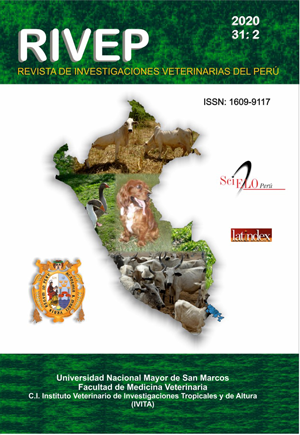EspañolCharacterization of canine neoplasms diagnosed by histopathology at the laboratory of Histology and Pathology Veterinary of the Universidad Peruana Cayetano Heredia: period 2003-2015
DOI:
https://doi.org/10.15381/rivep.v31i2.16155Keywords:
neoplasia, histopathology, carcinoma, canineAbstract
The purpose of this study was to determine the frequency of canine neoplasia between 2003 and 2015 diagnosed by histopathology at the Laboratory of Veterinary Histology and Pathology from the Cayetano Heredia Peruvian University. A total of 2620 cases were analyzed which only the 46.3% of them were included in this study. The morphologic diagnosis of neoplasia was reclassified according to "International Histological Classification of Tumors of Domestic Animals" (WHO-AFIP), excluding mammary tumors which were classified according to Goldschmidt et al. (2011). Sex, age, breed, anatomical location of sample, morphological or clinical features and grade of malignancy were recorded and analyze by statistical analysis. Squamous cell carcinoma was the most frequent neoplasia observed in dogs, being female and geriatric patients the most affected (60.7 and 54.4% respectively). Mixed breed showed a higher prevalence of neoplasia (35.7%); furthermore, the presence of a tumor was the most common clinical presentation (93.7%), mainly located in the integumentary system (51.2%) and mammary gland (23.6%). The 72.1% of neoplasms exhibited malignancy features. An association was found with the presence of an inflammatory process with the malignancy of the neoplasia. A further evaluation by immunochemistry is required in order to obtain an accurate diagnosis.
Downloads
Downloads
Published
Issue
Section
License
Copyright (c) 2020 Renato Aco Alburqueque, Javier Mamani, Ricardo Grandez

This work is licensed under a Creative Commons Attribution-NonCommercial-ShareAlike 4.0 International License.
AUTHORS RETAIN THEIR RIGHTS:
a. Authors retain their trade mark rights and patent, and also on any process or procedure described in the article.
b. Authors retain their right to share, copy, distribute, perform and publicly communicate their article (eg, to place their article in an institutional repository or publish it in a book), with an acknowledgment of its initial publication in the Revista de Investigaciones Veterinarias del Perú (RIVEP).
c. Authors retain theirs right to make a subsequent publication of their work, to use the article or any part thereof (eg a compilation of his papers, lecture notes, thesis, or a book), always indicating the source of publication (the originator of the work, journal, volume, number and date).










